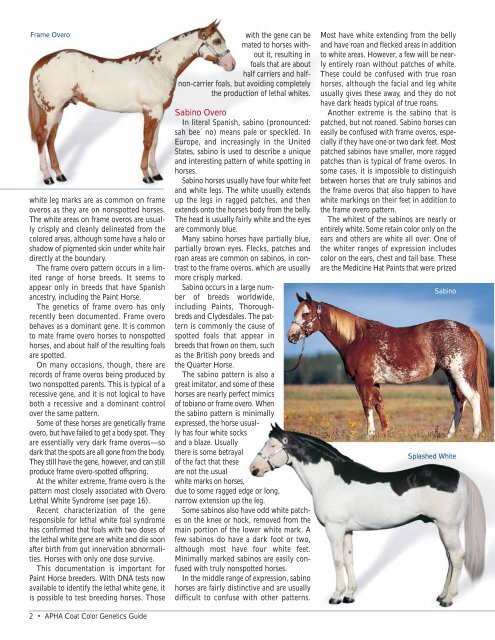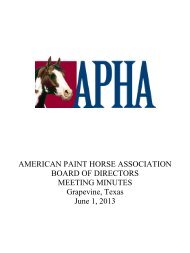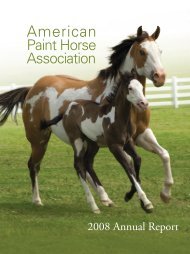Coat Color Genetics - Press - American Paint Horse Association
Coat Color Genetics - Press - American Paint Horse Association
Coat Color Genetics - Press - American Paint Horse Association
You also want an ePaper? Increase the reach of your titles
YUMPU automatically turns print PDFs into web optimized ePapers that Google loves.
Frame Overo<br />
white leg marks are as common on frame<br />
overos as they are on nonspotted horses.<br />
The white areas on frame overos are usually<br />
crisply and cleanly delineated from the<br />
colored areas, although some have a halo or<br />
shadow of pigmented skin under white hair<br />
directly at the boundary.<br />
The frame overo pattern occurs in a limited<br />
range of horse breeds. It seems to<br />
appear only in breeds that have Spanish<br />
ancestry, including the <strong>Paint</strong> <strong>Horse</strong>.<br />
The genetics of frame overo has only<br />
recently been documented. Frame overo<br />
behaves as a dominant gene. It is common<br />
to mate frame overo horses to nonspotted<br />
horses, and about half of the resulting foals<br />
are spotted.<br />
On many occasions, though, there are<br />
records of frame overos being produced by<br />
two nonspotted parents. This is typical of a<br />
recessive gene, and it is not logical to have<br />
both a recessive and a dominant control<br />
over the same pattern.<br />
Some of these horses are genetically frame<br />
overo, but have failed to get a body spot. They<br />
are essentially very dark frame overos—so<br />
dark that the spots are all gone from the body.<br />
They still have the gene, however, and can still<br />
produce frame overo-spotted offspring.<br />
At the whiter extreme, frame overo is the<br />
pattern most closely associated with Overo<br />
Lethal White Syndrome (see page 16).<br />
Recent characterization of the gene<br />
responsible for lethal white foal syndrome<br />
has confirmed that foals with two doses of<br />
the lethal white gene are white and die soon<br />
after birth from gut innervation abnormalities.<br />
<strong>Horse</strong>s with only one dose survive.<br />
This documentation is important for<br />
<strong>Paint</strong> <strong>Horse</strong> breeders. With DNA tests now<br />
available to identify the lethal white gene, it<br />
is possible to test breeding horses. Those<br />
2 • APHA <strong>Coat</strong> <strong>Color</strong> <strong>Genetics</strong> Guide<br />
with the gene can be<br />
mated to horses without<br />
it, resulting in<br />
foals that are about<br />
half carriers and halfnon-carrier<br />
foals, but avoiding completely<br />
the production of lethal whites.<br />
Sabino Overo<br />
In literal Spanish, sabino (pronounced:<br />
sah bee´ no) means pale or speckled. In<br />
Europe, and increasingly in the United<br />
States, sabino is used to describe a unique<br />
and interesting pattern of white spotting in<br />
horses.<br />
Sabino horses usually have four white feet<br />
and white legs. The white usually extends<br />
up the legs in ragged patches, and then<br />
extends onto the horse’s body from the belly.<br />
The head is usually fairly white and the eyes<br />
are commonly blue.<br />
Many sabino horses have partially blue,<br />
partially brown eyes. Flecks, patches and<br />
roan areas are common on sabinos, in contrast<br />
to the frame overos, which are usually<br />
more crisply marked.<br />
Sabino occurs in a large number<br />
of breeds worldwide,<br />
including <strong>Paint</strong>s, Thoroughbreds<br />
and Clydesdales. The pattern<br />
is commonly the cause of<br />
spotted foals that appear in<br />
breeds that frown on them, such<br />
as the British pony breeds and<br />
the Quarter <strong>Horse</strong>.<br />
The sabino pattern is also a<br />
great imitator, and some of these<br />
horses are nearly perfect mimics<br />
of tobiano or frame overo. When<br />
the sabino pattern is minimally<br />
expressed, the horse usually<br />
has four white socks<br />
and a blaze. Usually<br />
there is some betrayal<br />
of the fact that these<br />
are not the usual<br />
white marks on horses,<br />
due to some ragged edge or long,<br />
narrow extension up the leg.<br />
Some sabinos also have odd white patches<br />
on the knee or hock, removed from the<br />
main portion of the lower white mark. A<br />
few sabinos do have a dark foot or two,<br />
although most have four white feet.<br />
Minimally marked sabinos are easily confused<br />
with truly nonspotted horses.<br />
In the middle range of expression, sabino<br />
horses are fairly distinctive and are usually<br />
difficult to confuse with other patterns.<br />
Most have white extending from the belly<br />
and have roan and flecked areas in addition<br />
to white areas. However, a few will be nearly<br />
entirely roan without patches of white.<br />
These could be confused with true roan<br />
horses, although the facial and leg white<br />
usually gives these away, and they do not<br />
have dark heads typical of true roans.<br />
Another extreme is the sabino that is<br />
patched, but not roaned. Sabino horses can<br />
easily be confused with frame overos, especially<br />
if they have one or two dark feet. Most<br />
patched sabinos have smaller, more ragged<br />
patches than is typical of frame overos. In<br />
some cases, it is impossible to distinguish<br />
between horses that are truly sabinos and<br />
the frame overos that also happen to have<br />
white markings on their feet in addition to<br />
the frame overo pattern.<br />
The whitest of the sabinos are nearly or<br />
entirely white. Some retain color only on the<br />
ears and others are white all over. One of<br />
the whiter ranges of expression includes<br />
color on the ears, chest and tail base. These<br />
are the Medicine Hat <strong>Paint</strong>s that were prized<br />
Sabino<br />
Splashed White




